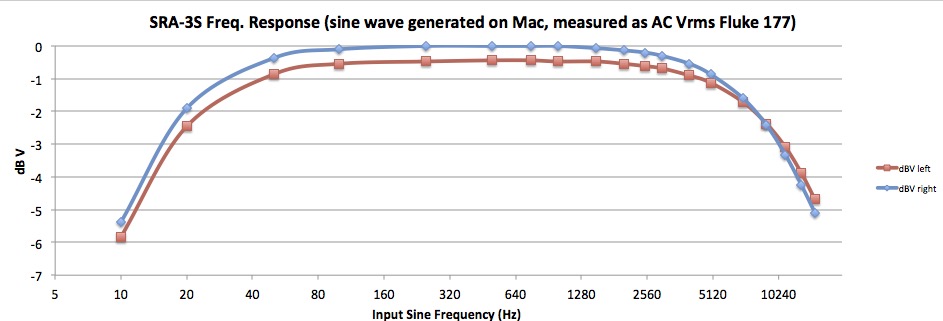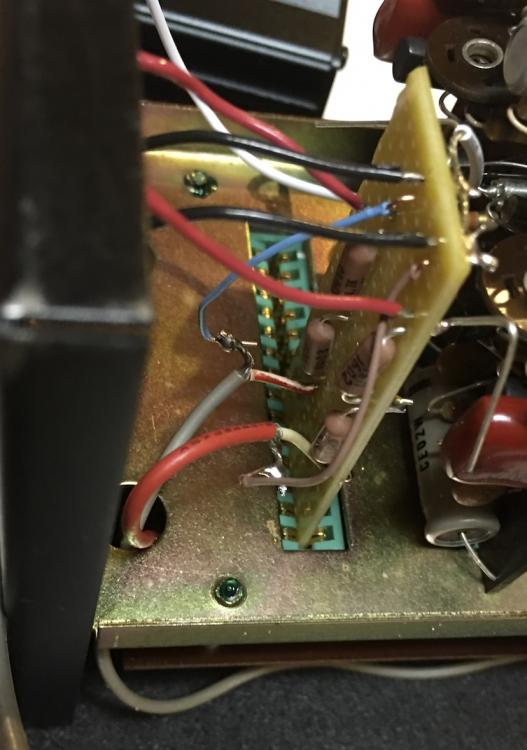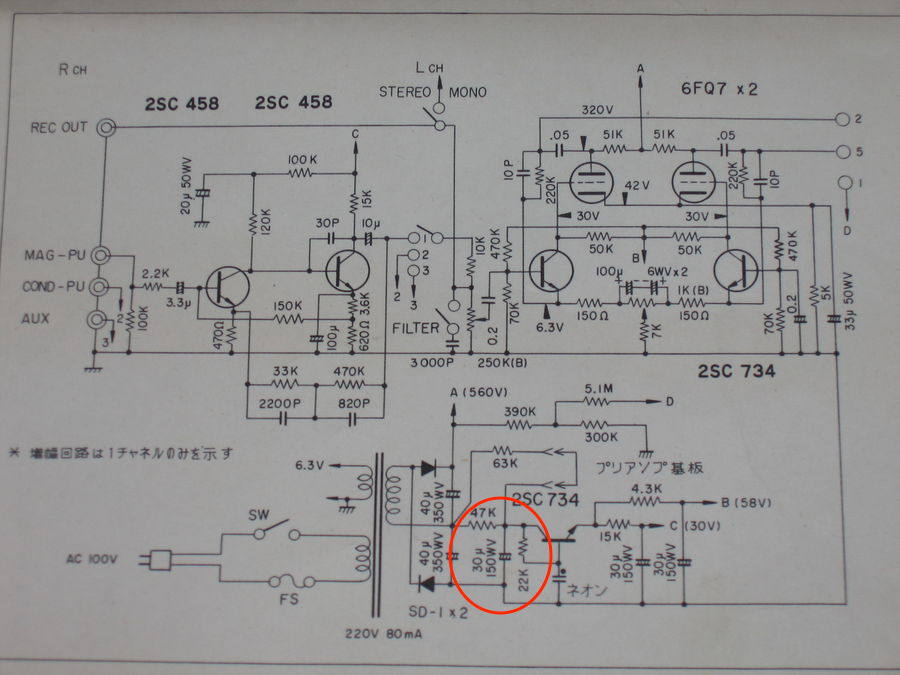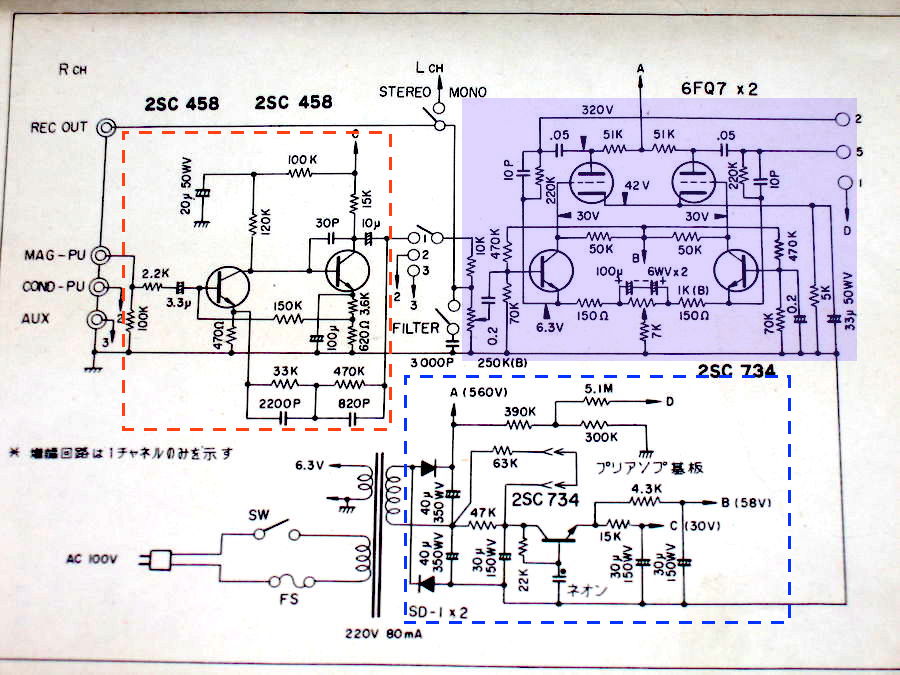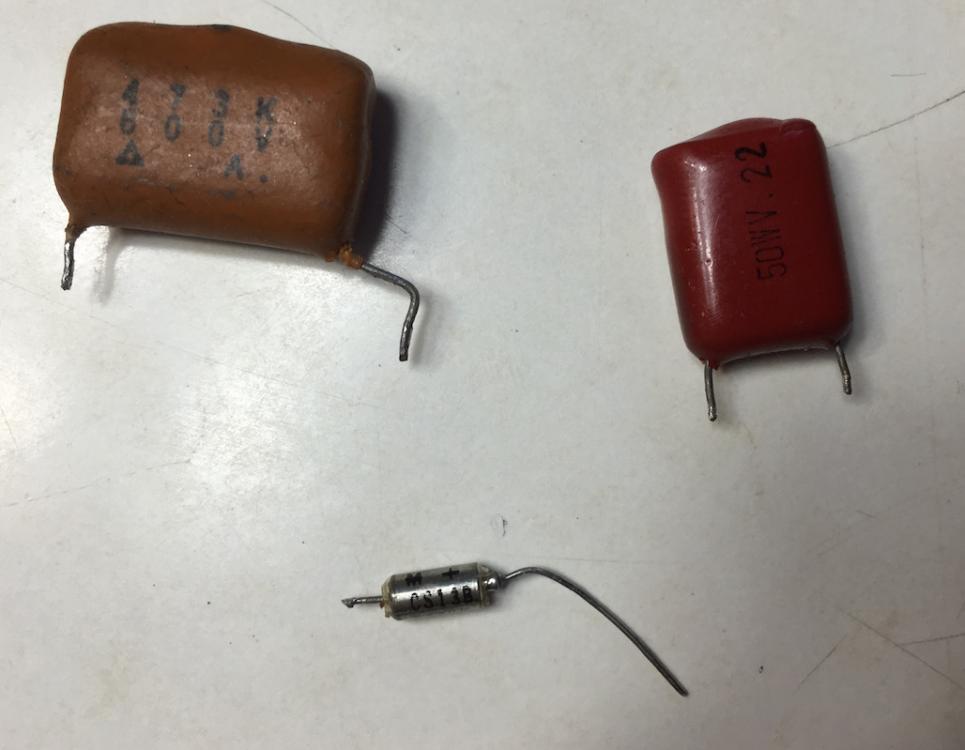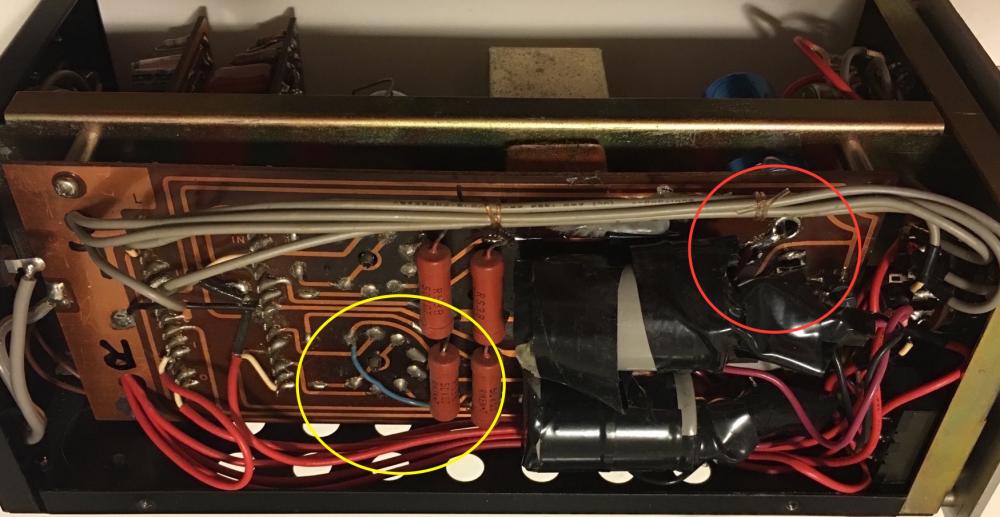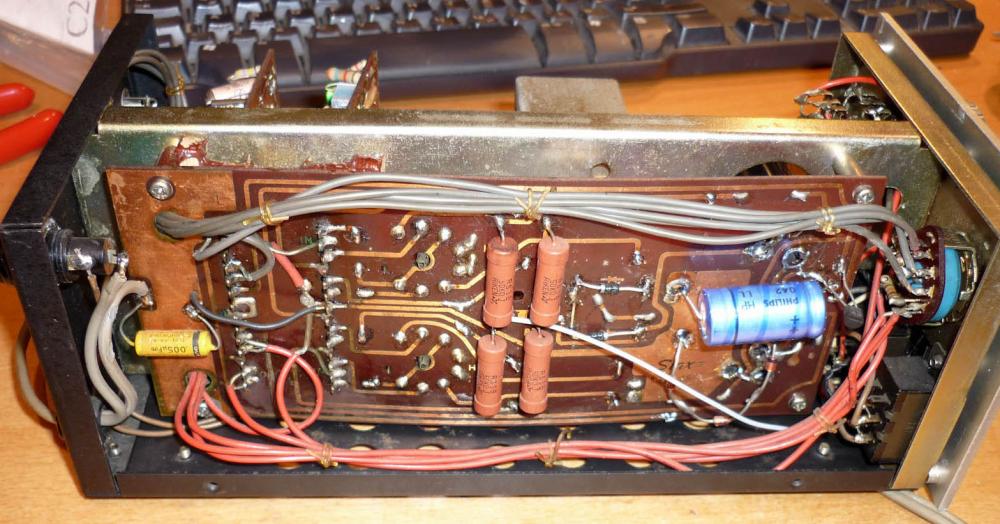-
Posts
310 -
Joined
-
Last visited
Content Type
Profiles
Forums
Events
Everything posted by oogabooga
-
I've always found Backblaze's stats/reports to be a well written and useful: https://www.backblaze.com/b2/hard-drive-test-data.html
-
Created HV bias from 603V B+ into a 23K-390K-390K voltage divider to get 585V measured just before the 5M1 ballast resistor. The plug-in card refurb will wait until I've enjoyed the amp for a bit :-) Thanks again for your suggestions Spritzer. I used lubricating contact cleaner on the pot, and ended up finding enough shielded wire from the previous stuff to run the audio. Oh - as to that 'side' mounting, after poking around a bit, I'm convinced that the giant 50K resistors are a major reason Stax designed the amp on it's 'side'. They get DAMN hot and would probably melt if they were under the PCB. I measured the frequency response using a sine wave generator on my Mac and the AC Vrms reading of my Fluke via the headphone sockets. I set the volume pot so that a 1 kHz wave was 250 Vrms and measured at 19 frequencies on both channels. Attached log plots shows was normalized to 0 dBV @ 1 kHz. The bass rolloff is slightly more than I calculated for 0.22 uF caps into a 145KOhm impedance load, but -2 dB @ 20 Hz is more than great for me. The high frequency rolloff is about 4x stronger than on my SRM-323 and is probably why this amp sounds less fatiguing than the SRM-323 with my Lambda Pros :-) Almost makes one think Stax designed the Lambda Pro to go with a tube amp... PS - I recreated the circuit in falstad.com: http://tinyurl.com/zlxjj9d The simulator seems to work (better) if I replace the the triodes with N-mosfets, but the output signal still looks screwy. That being said it's still a great website for smaller circuits.
-
I used VMware at my last job to run Windows NT, XP, 7, and Centos 6. It works very well. Seamless integration, excellent speed. Features like drag and drop sharing, shared clipboards and folders, and the like all worked well. Only gripe is that one usually has to do a paid upgrade to VMware if they do a major OSX update. They don't seem to care much about maintaining compatibility IMHO. At my current job I've used Virtualbox to run WinXP. The VM works fine, although I cannot get drag and drop sharing to work at all - the VM crashes whenever I try. Printing had some growing pains, too. It's also noticeably slower to suspend/restart a VM. That being said, it does the basic job and is free. If you have the money, I strongly recommend VMware. Haven't used Parallels in many years so I can't comment on that.
-
Thanks Spritzer, catscratch, and MrSneis, I was able to get the housing off (the adhesive had 'melted') and indeed all is as you describe. I'll scrape off as much glue as I can and wipe the rest down with 100% isopropanol (if anyone knows of a better solvent please do share!). When I repaired my Lambda Pros, I used Double Sided Hercules Tape. The only kind of PU glue I know of is Gorilla Glue - is there something better out there?
-
Used a rotary tool for the first time and wondered why I didn't buy one 10 years ago.
-
PSU done! With no source connected, the "A" line (aka B+) is running a bit high at 603V, the "B" line measured ~56V, and normal bias is ~260V, measured before the 5M1 resistor. In the original design, the 10K input resistors are soldered across the contacts of the input selector switch. I'm not using the selector, so I put new resistors on perfboard and stuck that into the plugin slot for the Mag PU card. Connected a source and played a 1 kHz sine wave: maxed out at ~380Vrms output to the left and right channels. Played some music and the distortion I had before is gone! Pot is no longer scratchy, either (contact cleaner). Next step is to redo the input/pot audio wiring. Stax used shielded wire but the ends look like crap and the wires are too short to trim, so it's all got to go. Will single conductor pick up anything from inside the amp? Also, why the heck did Stax design this amp to lay on its 'side'? It just seems like sub-optimal cooling for the tubes...
-
I found 100% isopropanol to work well, and wiping it off while still wet like muskyhuntr says helped eliminate residues.
-
Refurbished my SRA-3S PSU board today (except the HV caps that I'll place tomorrow after putting it back together). Three copper traces were already in a bad way when I started, and I broke a few more. Ran the blue 22AWG teflon-coated wire to fix. I've attached a picture so you can make fun of my soldering skills. I left a few mm on the component leads in case I need to reseat them... there'll be enough room in the case anyways thanks to those Rikens. For reference, I ended up replacing: diodes with 1N4007s, the five PSU resistors with Vishay BC PR02/PR03 2W/3W the three bias resistors with Vishay BC VR37 1/2W three LV PSU electrolytics with Nichicon VX 22-47 uF (the HV caps will be 180 uF 400V) four output film caps with Panasonic ECW-F(L) 0.22 uF 630V
-
You're right! Traced the paths - the two arrows connect to pins on the Mag PU card slot. There's a jumper bridging the two pins on the card, so when it's plugged in, the 63k resistor is parallel with the 47k.
-
Prepared for my university's 'annual power shutdown' happening tomorrow. The critical stuff we can't unplug goes on diesel generator backup... (i.e. crappy and surge-y power), and in two days, I find out what didn't survive!
-
Removed all the PSU caps, to find two resistors in the PSU (circled in red) looking terrible. One has it's casing blown clear off! The Vishay BC PR01 metal film resistors (1W) I have are much smaller than what Stax used. Is 3 W enough/safe here? I figure the voltage is 280V here, so that 47k resistor should top out at 1.7 W if it's other end was ground. Bias resistors are also cracking, going to replace these with 1/2W Vishay BC high voltage, ditto for the pro bias. I hope that's it for parts - one more order from Digikey and I can start putting it all back together! Thanks everyone for the help (Does anyone know that the two 'double arrows' just above and to the right of that red circle are? Never seen that symbol before and I can't find it on the board, or on Google.)
-
Thanks all for the suggestions, I've got a few choices now. Been avoiding eBay mostly because of delays with customs in Canada, but it looks like I can either have it cheap or fast... George - the offer is much appreciated but I'm gonna just buy a spool and get it over with
-
How normal is it for LNS drivers to be off-kilter? I just received a pair and the left driver looks fucked up. I removed the four screws on the driver to try and get a closer look, but I wasn't able to pull the driver/back plastic apart (didn't want to use too much force) - not sure if a previous owner glued em on. FWIW google turns up other LNS's that look like this: http://www.ebay.co.uk/itm/RARE-STAX-LAmbda-NOVA-Signature-/141886669059
-
1Password can store the initial two-factor authenticator key and generate one-time passwords just like Google Authenticator. However, it can also be backed up and syncs across devices (I have 1P on my Mac and iPhone) so I can get a one-time password from either. Perhaps its slightly less secure, but its a small penalty to pay for a lot of convenience.
-
I was afraid you'd say that. A 100 ft spool of 22 AWG teflon-insulated wire costs ~$75 at Mouser. So much for doing this repair on the cheap! For the 5k1 - is a 2W or 3W resistor about right? Buy 25 and match 2 pairs by hand? What's a mini SRA-3S?? How the heck can they make that thing any smaller!!
-
I want to replace the internal hookup wire in the SRA-3S - some of the wiring insulation is looking black/heated. How much do I have to worry about the voltage rating of the wire insulation? Is the 300V stuff I have on hand good enough or does it need to be 600V-rated? FWIW I'm going to make one of the jacks pro bias @ 560V.
-
I've desoldered the wiring to the front and rear panels, which helped me get a feel for the circuit, and realize that the entire upper half of the circuit diagram is duplicated for the other channel . Since I'm not touching the Mag PU section (in red), the shaded blue audio region is where I'll keep the same capacitance. For the audio section, I've found Elna SILMIC caps to replace the existing Elna electrolytic, but I have no idea on replacements for the 0.22 uF 50V and 0.05 uF 630V film caps. I've found options from Panasonic, Kemet, TDK... general purpose, high frequency switching, etc. Does it really matter for an SRA-3S? I really don't want to get the 0.05 uF 630V caps wrong b/c they'll be a bitch to replace once everything is back together.
-
Thanks Defqon and spritzer! I know enough to keep the same capacitance and voltage (or moar V), but that's about all I know. Digikey seems stock lots of Nichicon, Illinois, and Vishay BC - are there any brands to prefer or stay away from? Any other parameters to keep in mind when choosing a decent cap? I'm not looking to break the bank on the SRA-3S but I don't want crap either. If anyone's got the time, I think I've found some replacements and would appreciate any advice from those who've done this before! On the top of the main PCB: 1. two giant radials at 50 uF 350V (standing up on the PCB). Does upgrading to 100 uF here make sense - if so, would either of these work: http://www.digikey.ca/product-detail/en/nichicon/LKX2G101MESY35/493-14387-ND/2541222 http://www.digikey.ca/product-detail/en/vishay-bc-components/MAL215937101E3/4814PHBK-ND/5637711 2. four orange caps (metalized PP?) labelled "473K 600V". The one in the photo measures 49 nF on the Fluke - would one of these work: http://www.digikey.ca/product-detail/en/epcos-tdk/B32642B0473J/495-7144-ND/5414294 http://www.digikey.com/product-detail/en/kemet/PHE450PD5470JR06L2/399-7724-ND/3465772 On the pickup card: 3. four ceramic caps labelled "5-D". Are these 5 pF, and would this work? http://www.digikey.com/product-detail/en/murata-electronics-north-america/RCE5C2A5R0C0DBH03A/490-7480-1-ND/4277397 4. two film caps (metalized PP?) labelled 50WV .22. The one in the photo measures 270 nF on my Fluke. Would either of these work? http://www.digikey.ca/product-detail/en/vishay-bc-components/BFC241642204/BC2062-ND/502842 http://www.digikey.ca/product-detail/en/rubycon/250MPH224J/1189-1804-ND/3720026 5. two caps I can't ID labelled CS13B/F334K/7924A. Best guess is this is a 0.33 uF tantalum cap, 6V, 10% tolerance. The one in the bottom of the photo measures ~450 nF on the Fluke. Is this about right: http://www.digikey.ca/product-detail/en/kemet/T322A334K035AT/399-4596-ND/946614 6. four radial ELNA 100 uF 6.3 V: http://www.digikey.ca/product-detail/en/RFS-6V101MG3%235/604-1134-ND/2171185 7. two axial ELNA 33 uF 50 V http://www.digikey.ca/product-detail/en/elna-america/RFS-100V330MI5%235/604-1105-ND/2171156 (this is radial, so I'd have to jerry-rig it). http://www.digikey.ca/product-detail/en/vishay-bc-components/MAL202138339E3/4069PHCT-ND/263272 Thanks!
-
Trying to fix my old SRA-3S (distortion on one of the channels, scratchy pot). Going to replace all caps and clean the pot. I did find the schematic Spritzer provided elsewhere, but I don't know enough EE to reconcile it and changes the previous owner made. Much easier is looking at Spritzer's rebuilds and seeing where mine is different 1. On each channel, two giant caps are connected in parallel to a triangle of mounting holes (red circle in the photo). One cap is on each side of the PCB - am I right to assume that the bottom, tape covered caps shouldn't be there? Would it be best to just remove both caps and replace them with a single Philips 100 uF cap at 500V or higher on each channel? (http://www.head-fi.org/t/677809/the-stax-thread-iii/360#post_9796944) (also, why three mounting holes?? I thought caps only had two posts). 2. A blue wire was added to the bottom of the PCB between the 50 K resistor and the tube socket... but only on one channel (yellow circle in the photo). Does this make sense to anyone? I've attached Spritzer's rebuild and the schematic. From what I can tell, the upper left portion of the schematic is for the phono pickup which I don't much care about.
-
http://www.sonnettech.com/product/echo15thunderboltdock.html Might be just wat the doctor ordered for you thunderbolt-y folks.
-
I've own four different pairs from the Clarks Unstructured line. No problems wearing them all day long, they are light, breathable, comfortable and I don't have pain from walking. I used to wear Eccos, but switched to the Clarks because they worked better for me and cost less. Amazing to me how different they are from the 'regular' Clarks line, which I find heavy as hell and highly uncomfortable. Mind you, at work I wear Crocs with socks (and don't give a shit what people say...).
-
Managed to run a ground wire, and everything sounds great Thanks to all for the help!
-
FWIW I loved the Weber Smokey Mountain, until we moved to an apartment where I can't use it. Kinda small though.
-
Good idea Peter - I ran a long extension cable from a grounded outlet in the kitchen to my desk/audio gears. No hum at all. There's no plumbing anywhere near my desk, so I'll have to get creative!<br />
-
Yea and yea. I turn my head, the hum turns with me. I take the SR-002s out of my ear, I don't hear a hum. All with the cable not being plugged into anything. I checked my wall receptacle with a DMM - as far as I can tell the ground pin on the jack is not connected to anything at all. I think something is radiating - I do have three 120V-100V stepdowns (one of which is switching) that might be causing the problem. Sadly the nearest earth is two rooms away, although I may have to bite the bullet and run a long extension cord throughout the house.


